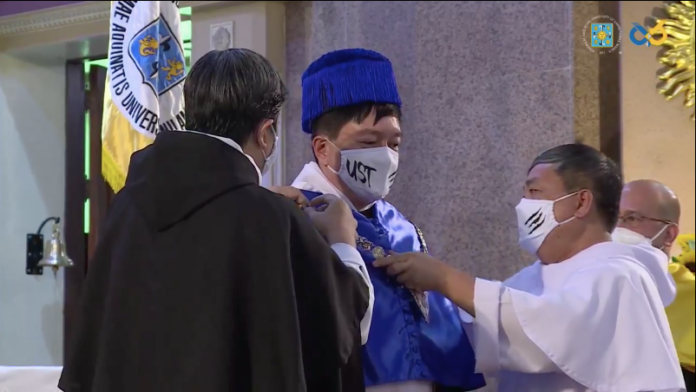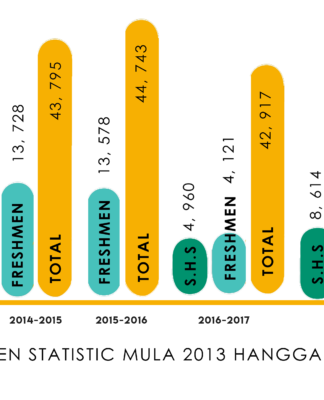
Fr. Richard G. Ang, O.P. formally assumed office as the 97th Rector of UST on Thursday, unveiling a roadmap to ensure the University’s survival beyond the Covid-19 pandemic.
The installation rites, which were delayed by a year after Ang went on medical leave, were markedly simpler and attended only by top administrators and UST fathers because of quarantine protocols.
After reading the appointment decree from the Vatican’s Sacred Congregation for Catholic Education and Seminaries, UST Vice Chancellor Fr. Filemon I. de la Cruz, Jr., O.P., prior provincial of the Dominican Province of the Philippines, administered the solemn oath of office on Ang, who knelt at the sanctuary of the Santisimo Rosario Parish Church.
In his inaugural message, Ang said being at the helm of UST amid the Covid-19 pandemic was a huge challenge, but assured Thomasians that under him, UST would “continue to adapt to the changes no matter how disruptive they may be.”
He also unveiled his plans for his four-year tenure, summarized by seven key points: upgrading UST’s information and communications technology infrastructure; advancing synergy among University disciplines, offices and institutions; enriching the research ecosystem of UST; furthering internationalization; strengthening industry-academe-alumni partnerships; advocating for the well-being of all University stakeholders; and strategic resource management for UST’s expansion.
The four-year roadmap, dubbed “UST Vision 2024 and Beyond,” aims to make the University “one of the leading Catholic institutions of learning in the Asean region, with the fastest growing reputation in education, research and service,” he said.
Improved information technology infrastructure
Ang underscored the importance of upgrading the University’s information technology (IT) infrastructure to ensure the delivery of quality education, especially amid the Covid-19 pandemic.
“Prompted by the shift to the remote teaching and learning environment, UST will consider upgrading IT infrastructure for increased accessibility, connectivity and speed,” he said.
Ang introduced the “enriched virtual mode,” UST’s distance learning strategy, in May 2020. The mode of instruction makes use of synchronous and asynchronous learning strategies using the UST Cloud Campus.
READ: UST introduces ‘enriched virtual mode’
“Poor digital scales and connectivity issues remain to be roadblocks among most of our learners. We are aware of the importance of IT integration in education,” Ang said.
Synergy
The Rector urged deans and administrative officials to innovate courses and make them more “interdisciplinary.”
He also called on different units of the University to do away with “crab mentality.”
“In my administration, I am empowering all of you to collaborate, not to compete, to cooperate and not to outdo each other. Let us cultivate a culture of support and rapport. I say: down with crab mentality, out with envy—they have no place in this Catholic University,” he said.
UST will collaborate more with other Dominican Province of the Philippines schools such as the Letran colleges, he said.
“We may have distinct systems as educational institutions, but we all share the same Dominican roots. We will strive to walk hand-in-hand with other Dominican schools through sustainable partnerships that will bring mutual benefits to our schools,” he added.
More research, internationalization
For his third agenda, the Rector urged the research clusters of the University to double down on their efforts and be open to more diverse topics, especially on the natural sciences and humanities.
“There is a need to revisit and recalibrate the research policies and guidelines of the University: We should be open to more diversity,” Ang said.
“Researchers should not forget about ethics and morals. We have a social responsibility as a Catholic institution,” he added.
Ang said he wanted to see more collaboration between the University and its partner-institutions abroad.
In the long run, Ang said the campus would be diversified by slowly increasing the number of foreign students and by inviting more foreign scholars to the University through grants.
“I am convinced that we will steadily rebuild from the rubble and the University will make headway in our internationalization efforts in the very near future when the virus is defeated. The virus must be defeated,” he said.
Expansion to Santa Rosa, GenSan
Ang admitted that the University had seen a decrease in revenues due to the pandemic and the implementation of the K-12 curriculum.
He said the University would strengthen industry-academe-alumni partnerships, which he said could bring alternative sources of funding for the University.
“We may need to focus on financial sustainability in the long run. I believe that we may have to diversify our financial resources by exploring external funding and philanthropic support to fulfill our vision and mission. It wouldn’t hurt if we practice frugality and simplicity,” he said.
In the next five years, there will be “gradual progress” in the construction of the first quadrant of the UST Santa Rosa campus and the main building of the UST General Santos (GenSan) City campus, Ang said.
READ: Construction of P100-M innovation hub at UST Santa Rosa begins
He said the Santa Rosa campus would initially offer science and engineering programs, while health sciences, business and accountancy, engineering and technology and pharmacy and pharmaceutical science programs would be offered in UST GenSan.
“We shall start small, but we need to prepare the manpower and program designs as early as now. Anticipation is the rule of the game,” he said.
First Chinese-Filipino rector
A Thomasian himself, Ang graduated from the Faculty of Arts and Letters with a bachelor’s degree in philosophy in 1990, and in sacred theology in 1997 from the Ecclesiastical Faculties.
He completed a double degree and graduated with a licentiate in sacred theology and a master’s degree in religious studies at the Ecclesiastical Faculties and the Graduate School in 1999.
He then earned his doctorate in philosophy at the Ecclesiastical Faculties in 2010. He consistently received Latin honors throughout his years as a student of UST.
Ang, who was ordained to the priesthood in 1998, was vice rector of UST for eight years under the rectorship of his predecessor, Fr. Herminio Dagohoy, O.P.
READ: Dagohoy: ‘Pray for me and remember me with gladness’
Ang topped the voting of the Academic Senate on the terna or list of three eligible candidates produced through secret balloting by the Dominican fathers in UST.
READ: Fr. Richard Ang, O.P. named 97th Rector Magnificus of UST
Since assuming the rectorship, Ang has led UST’s transition to distance learning and finalized the new collective bargaining agreement of faculty members for 2016 to 2021.
According to the University’s general statutes, the Rector, as the chief executive officer of the University is responsible for the promulgation of laws and rules in the University, appointment of heads and officials, crafting of the annual budget of the University, and the approval of programs and semestral schedules of all faculties, colleges and schools.














